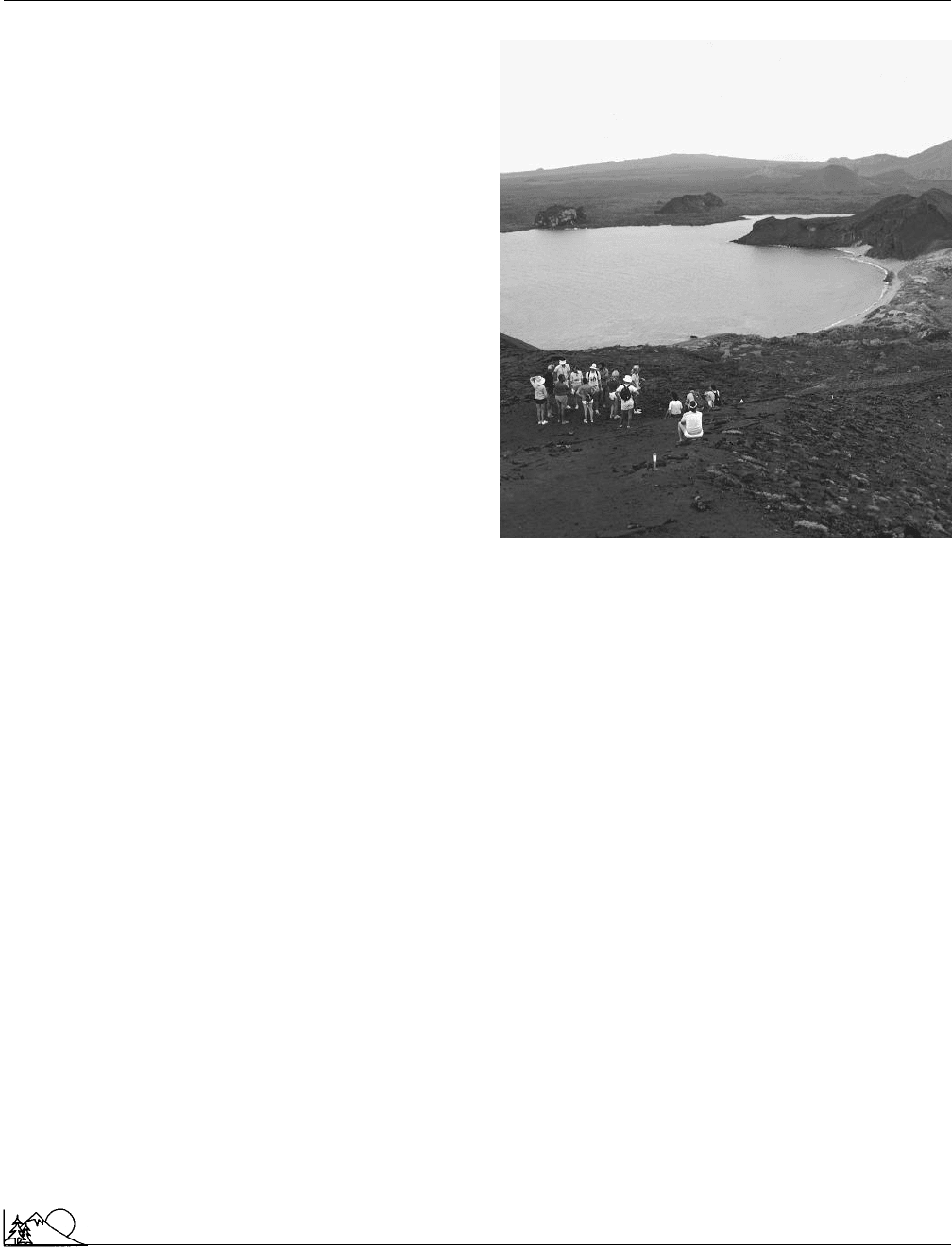Environmental Encyclopedia
Подождите немного. Документ загружается.


Environmental Encyclopedia 3
Ecosystem
few years by Evelyn Hutchinson, Raymond Lindeman, and
the Odum brothers, Eugene and Howard.
The boundaries of an ecosystem can be somewhat
arbitrary, reflecting the interest of a particular ecologist in
studying a certain portion of the landscape. However, such
a choice may often represent a recognizable landscape unit
such as a woodlot, a wetland, a stream or lake, or—in the
most logical case—a
watershed
within a sealed geological
basin, whose exchanges with the
atmosphere
and outputs
via stream flow can be measured quite precisely. Inputs and
outputs imply an
open system
, which is true of all but the
planetary or global ecosystem, open to
energy flow
but
effectively closed in terms of materials except in the case of
large-scale asteroid impact.
Ecosystems exhibit a great deal of structure, as may
be seen in the vertical partitioning of a forest into tree, shrub,
herb, and moss layers, underlain by a series of distinctive
soil
horizons. Horizontal structure is often visible as a mosaic
of patches, as in forests with gaps where trees have died and
herbs and shrubs now flourish, or in bogs with hummocks
and hollows supporting different kinds of plants. Often the
horizontal structure is distinctly zoned, for instance around
the shallow margin of a lake; and sometimes it is beautifully
patterned, as in the vast
peatlands
of North America that
reflect a very complicated
hydrology
.
Ecosystems exhibit an interesting functional organiza-
tion in their processing of energy and matter. Green plants,
the primary producers of organic matter, are consumed by
herbivores, which in turn are eaten by carnivores that may
in turn be the prey of other carnivores. Moreover, all these
animals may have
parasites
as another set of consumers.
Such sequences of producers and successive consumers con-
stitute a food chain, which is always part of a complicated,
inter-linked food web along which energy and materials
pass. At each step along the food chain some of the energy
is egested or passed through the organisms as feces. Much
more is used for metabolic processes and—in the case of
animals—for seeking food or escaping predators; such energy
is released as heat. As a consequence only a small fraction
(often of the order of 10%) of the energy captured at a given
step in the food chain is passed along to the next step.
There are two main types of food chains. One is made
up of plant producers and animal consumers of living organ-
isms, which constitute a grazing food chain. The other con-
sists of organisms that break down and metabolize dead
organic matter, such as earthworms,
fungi
, and bacteria.
These constitute the
detritus
food chain. Humans rely
chiefly on grazing food chains based on
grasslands
, whereas
in a forest it is usual for more than 90% of the energy trapped
by
photosynthesis
to pass along the detritus food chain.
Whereas energy flows one way through ecosystems
and is dispersed finally to the atmosphere as heat, materials
427
are partially and often largely recycled. For example,
nitro-
gen
in rain and snow may be taken up from the soil by
roots, built into leaf protein that falls with the leaves in
autumn, there to be broken down by soil
microbes
to ammo-
nia and nitrate and taken up once again by roots. A given
molecule of nitrogen may go through this
nutrient
cycle
again and again before finally leaving the system in stream
outflow. Other nutrients, and
toxins
such as
lead
and
mer-
cury
, follow the same pathway, each with a different
resi-
dence time
in the forest ecosystem.
Mature ecosystems exhibit a substantial degree of
sta-
bility
, or dynamic equilibrium, as the endpoint of what is
often a rather orderly
succession
of
species
determined
by the
nature
of the
habitat
. Sometimes this successional
process is a result of the differing life spans of the colonizing
species, at other times it comes about because the colonizing
species alter the habitat in ways that are more favorable to
their competitors, as in an
acid
moss bog that succeeds a
circumneutral sedge fen that has in its turn colonized a pond
as a floating mat. Equilibrium may sometimes be represented
on a large scale by a relatively stable mosaic of small-scale
patches in various stages of succession, for instance in fire-
dominated pine forests. On the millennial time scale, of
course, ecosystems are not stable, changing very gradually
owing to immigration and emigration of species and to
evolutionary changes in the species themselves.
The structure, function, and development of ecosys-
tems are controlled by a series of partially independent envi-
ronmental factors:
climate
, soil parent material,
topogra-
phy
, the plants and animals available to colonize a given
site, and disturbances such as fire and windthrow. Each
factor is, of course, divisible into a variety of components,
as in the case of temperature and precipitation under the
general heading of climate.
There are many ways to study ecosystems. Evelyn
Hutchinson divided them into two main categories, holistic
and meristic. The former treats an ecosystem as a “black
box” and examines inputs, storages, and outputs, for example
in the construction of a lake’s heat budget or a watershed’s
chemical budget. This is the physicist’s or engineer’s ap-
proach to how ecosystems work. The meristic point of view
emphasizes analysis of the different parts of the system and
how they fit together in their structure and function, for
example the various zones of a wetland or a
soil profile
,or
the diverse components of food webs. This is the biologist’s
approach to how ecosystems work.
Ecosystem studies can also be viewed as a series of
elements. The first is, necessarily, a description of the system,
its location, boundaries, plant and animal communities, envi-
ronmental characteristics, etc. Description may be followed
by any or all of a series of additional elements, including:
1) a study of how a given ecosystem compares with others

Environmental Encyclopedia 3
Ecosystem health
locally, regionally, or globally; 2) how it functions in terms
of hydrology, productivity, and biogeochemical cycling of
nutrients and toxins; 3) how it has changed over time; and
4) how various environmental factors have controlled its
structure, function, and development. Such studies involve
empirical observations about relationships within and among
ecosystems, experiments to test the causality of such relation-
ships, and model-building to assist in forecasting what may
happen in the future.
The ultimate in ecosystem studies is a consideration
of the structure, function, and development of the global
or planetary ecosystem, with a view to understanding and
mitigating the deleterious impacts upon it of current human
activities. See also Biotic community
[Eville Gorham Ph.D.]
R
ESOURCES
B
OOKS
Hagen, J. B. An Entangled Bank, the Origins of Ecosystem Ecology. New
Brunswick, NJ: Rutgers University Press, 1992.
P
ERIODICALS
Herbertson, A. J. “The Higher Units: A Geological Essay.” Scientia 14
(1913): 199-212.
Tansley, A. G. “The Use and Abuse of Vegetational Concepts and Terms.”
Ecology 16 (1935): 284-307.
Ecosystem health
Ecosystem
health is a new concept that ecologists are exam-
ining as a tool for use in detecting and monitoring changes
in the quality of the
environment
, particularly with regard
to ecological conditions.
Ecosystem health (and
ecological integrity
)isanin-
dicator of the well-being and natural condition of ecosystems
and their functions. These indicators are influenced by natu-
ral changes in environmental conditions, and are related to
such factors as
climate
change and disturbances such as
wildfire
, windstorms, and diseases. Increasingly, however,
ecosystems are being affected by environmental stressors
associated with human activities that cause
pollution
and
disturbance, which result in many changes in environmental
conditions. Some
species
, communities, and ecological pro-
cesses benefit from those environmental changes, but others
suffer great damages.
The notion of ecosystem health is intended to help
distinguish between ecosystem-level changes that represent
improvements and those that are considered to be degrada-
tions. In the sense meant here, ecosystem-level refers to
responses occurring in ecological communities, landscapes,
or seascapes. Effects on individual organisms or populations
428
do not represent an ecosystem-level response to changes in
environmental conditions.
The notion of health
The notion of ecosystem health is analogous to that
of medical health. In the medical sense, health is a term used
to refer to the vitality or well-being of individual organisms.
Medical health is a composite attribute, because it is charac-
terized by a diversity of inter-related characteristics and con-
ditions. These include blood pressure and chemistry, wounds
and injuries, rational mental function and many other rele-
vant variables. Health is, in effect, a summation of all of these
characters related to vitality and well-being. In contrast, a
diagnosis of unhealthiness would focus on abnormal values
for only one or several variables within the diverse congrega-
tion of health-related attributes. For example, an individual
might be judged as being unhealthy because they had a
broken leg, or a high fever, or unusually high blood pressure,
or non-normal behavioral traits, even though they are “nor-
mal” with regards to all other traits.
To compare human and ecosystem health is, however,
imperfect in some important respects. Health is a relative
concept. It depends on what we consider “normal” at a
particular stage of development. The aches and pains that
are considered normal in a human at age 80 would be a
serious concern in a 20-year old. It is much more difficult,
however, to say what is to be expected in an ecosystem.
Ecosystems don’t have a prescribed lifespan and generally
don’t die but rather change into some other form. Because
of these problems, some ecologists prefer the notions of
ecological or biological integrity rather than ecosystem
health.
It should also be pointed out that many ecologists like
none of these notions (that is, ecosystem health, ecological
integrity, or biological integrity). The reason is that by their
very nature, these concepts are imprecise and difficult to
define. For these reasons, scientists have had difficulty in
agreeing upon the specific variables that should be included
when designing composite indicators of health and integrity
in ecological contexts.
Ecosystem health
Ecosystem health is a summation of conditions oc-
curring in communities, watersheds, landscapes, or sea-
scapes. Ecosystem health conditions are higher-level compo-
nents of ecosystems, in contrast with individual organisms
and their populations.
Although ecosystem health cannot be defined pre-
cisely, ecologists have identified a number of specific compo-
nents that are important in this concept. These include the
following indicators: (1) an ability of the system to resist
changes in environmental conditions without displaying a
large response (this is also known as
resistance
or tolerance);
(2) an ability to recover when the intensity of
environmental

Environmental Encyclopedia 3
Ecosystem management
stress
is decreased (this is known as
resilience
); (3) relatively
high degrees of
biodiversity
; (4) complexity in the structure
and function of the system; (5) the presence of large species
and top predators; (6) controlled
nutrient
cycling and a
stable or increasing content of
biomass
in the system; and
(7) domination of the system by native species and natural
communities that can maintain themselves without manage-
ment by humans. Higher values for any of these specific
elements imply a greater degree of ecosystem health, while
decreasing or lower values imply changes that reflect a less
healthy condition.
Ecologists are also working to develop composite indi-
cators (or multivariate summations) that would integrate the
most important attributes of ecosystem health into a single
value. Indicators of this type are similar in structure to com-
posite economic indicators such as the Dow-Jones Stock
Market Index and the Consumer Price Index. Because they
allow complex situations to be presented in a simple and
direct fashion, composite indicators are extremely useful for
communicating ecosystem health to the broader public.
[Bill Freedman Ph.D.]
R
ESOURCES
B
OOKS
Costanza, R., B.G. Norton, and B.D. Haskell. Ecosystem Health. New Goals
for Environmental Science. Washington, D.C.: Island Press, 1992.
DiGiulio, R., and E. Monosson. Interconnections Between Human and Eco-
system Health. New York: Chapman and Hall, 1996.
Woodley, S., J. Kay, and G. Francis, eds. Ecological Integrity and the Manage-
ment of Ecosystems. Boca Raton, FL: St. Lucie Press, 1993.
Ecosystem management
Ecosystem management (EM) is a concept that has germi-
nated within the past 20 years and continues to increase in
popularity across the United States and Canada. It is a
concept that eludes one concise definition, however, because
it embodies different meanings in different contexts and for
different people and organizations. This can be witnessed
by the multiple variations on its title, e.g., ecosystem-based
management or collaborative ecosystem management. The
definitions that have been given for EM, though varied, fall
into two distinct groups. One group emphasizes long term
ecosystem integrity, while the other group emphasizes an
intention to address all concerns equally, be they economic,
ecological, political or social, by actively engaging and incor-
porating the multitude of stakeholders (literally, those who
“hold a stake” in the issue) into the decision-making process.
One usable though incomplete definition of EM is
provided by R. Edward Grumbine: “Ecosystem management
integrates scientific knowledge of ecological relationships
429
within a complex sociopolitical and values framework toward
the general goal of protecting native ecosystem integrity
over the long term.” Ultimately, EM is a new way to make
decisions about how we humans should live with each other
and with the
environment
that supports us. And, it is best
defined not only by articulating an ideal description of its
contents, as Grumbine has done, but also through a rigorous
analysis of actual EM examples.
EM—a new management Style
Between the years 1992 and 1994, each of the four
predominant federal land management agencies in the
United States the
National Park Service
, the
Bureau of
Land Management
, the
Forest Service
and the
Fish and
Wildlife Service
implemented EM as their operative man-
agement paradigm. Combined, these four agencies com-
bined control 97% of the 650 million federally-owned acres
(267 million ha) in the United States, or roughly 30% of
the United States’ entire land area. EM has become the
primary management style for these agencies because of a
fact that became unavoidably apparent in the 1980s and
1990s the traditional resource management style does not
work. It is largely ineffective in addressing the loss and
fragmentation of wild areas, the increasing number of threat-
ened or
endangered species
, and the increased occurrence
of environmental disputes. This ineffectiveness has been at-
tributed to the traditional management style’s focus on
mainly
species
with economic value, its exclusion of the
public from the decision-making process, and its reliance
on outdated ecological beliefs. This explicit acknowledgment
that the traditional management style is inadequate has coa-
lesced within state and federal agencies, academia, and envi-
ronmental organizations, and has been bolstered by advances
in other relevant fields, such as
ecology
and conflict man-
agement.
If we break the traditional management style into indi-
vidual components, we see that each ineffective attribute has
a new or altered counterpart in EM. One of the best ways
to describe what EM actually entails is to explicate this
juxtaposition between traditional and new management
styles.
EM, as its name makes clear, concentrates on manag-
ing at the scale of an ecosystem. Alternately, traditional
resource management has tended to focus only on one or
a handful of species, especially those species that have a
utilitarian, or more specifically economic, value. For exam-
ple, the U.S. Forest Service has traditionally managed the
national forests so as to produce a sustained yield of timber.
This management style is often harmful to species other
than timber and can have negative effects on the entire
ecosystem. In EM, all significant biotic and abiotic compo-
nents of the ecosystem, as well as aspects such as economic
factors, are, ideally, reviewed and the important ecological

Environmental Encyclopedia 3
Ecosystem management
data incorporated into the decision-making process. For ex-
ample, review of a forest ecosystem may include an analysis
of
habitat
for significant song birds, a description of the
requirements needed to maintain a healthy black bear (Ursus
americanus) population, and a discussion of acceptable levels
of timber production.
A major problem associated with using an ecosystem
to define one’s management area is that boundaries of juris-
dictional authority, or political boundaries, rarely follow eco-
logical ones. This implies that by following political bound-
aries alone, ecological components may be left out of the
management plan one may be forced to manage only part
of an ecosystem, that part which is within one’s political
jurisdiction. For example, the Greater Yellowstone Ecosys-
tem goes far beyond the boundaries of
Yellowstone Na-
tional Park
. Therefore, a large scale EM project for Yel-
lowstone would require crossing several political boundaries
(e.g.,
national park
lands and
national forest
lands), which
is a difficult task because it entails several political jurisdic-
tions and political entities (e.g., state and federal agencies,
and county governments).
EM projects address this obstacle by forming decision
teams that include, among others, representatives from all
of the relevant jurisdictions. These decision-making bodies
can either act as advisory committees without decision-mak-
ing authority, or they can attempt to become vested with
the power to make decisions. This collaborative process in-
volves all of the stakeholders, whether that stakeholder is a
logging
company interested in timber production, or a pri-
vate citizen concerned with
water quality
. Such collabora-
tion diverges from the traditional resource management
method which made most decisions “behind closed doors”
asking for and receiving little public input. These agencies
traditionally shied away from actively engaging the public
because it is easier and faster to make decisions on one’s
own than to ask for input from many sources, there has
often been an antagonistic and distrustful relationship be-
tween state and federal agencies and the public, and, there
has been little institutional support (i.e., within the structure
of the agency itself) encouraging the manager in the field
to invite the public into the decision-making process.
EM’s more collaborative and inclusive decision-mak-
ing style ideally fosters a wiser and more effective decision.
This happens because as the decision team works toward
consensus, personal relationships are established, some trust
may form between parties, and, ultimately, people are more
likely to support a decision or plan they help create. EM
attempts to transcend the traditional antagonistic relation-
ship between agency personnel and the public. Because 70%
of the United States is privately owned, many environmental
issues arise on private land—land that is partially not affected
by federal and state natural resource legislation. EM allows
430
us to deal with these issues on private lands by establishing a
dialogue between private and public decision makers. Finally,
even though the EM decision-making style takes longer to
conduct, time is saved in the end because the decision
achieved is more agreeable to all interested parties. Having
all parties agree to a particular management plan decreases
the number of potential lawsuits which can arise and delay
the plan’s implementation.
Nonequilibrium ecology and EM
A change in the dominant theories in ecology has
encouraged this switch to EM and an ecosystem-level focus.
The idea that environments achieve a climax state of
homeostasis
has been a significant theory in ecology since
the early 1900s. This view, now discredited, was most vigor-
ously articulated by Frederic Clements and holds that all
ecosystems have a particular end point to which they each
progress, and that ecosystems are closed systems. Distur-
bances such as fires or floods are considered only temporary
setbacks on the ecosystem’s ultimate progression to a final
state. This theory offers a certain level of predictable
stability
the type of stability desired within traditional resource man-
agement. For example, if a forest is in its climax state, that
condition can be maintained by eliminating disturbances
such as forest fires, and a predictable level of harvestable
timber can be extracted (hence, this theory contributed to
the creation of “Smoky the Bear” and the national policy of
stopping forest fires on
public land
).
This teleological view of
nature
has ebbed and waned
in importance, but has lost favor especially within the past
two decades. Ecologists, among others, have realized that
from certain temporal and spatial points of view ecosystems
may seem to be in equilibrium, but in the long term all
ecosystems are in a state of nonequilibrium. That is, ecosys-
tems always change. They change because their ecological
structure and function is often regulated by dynamic external
forces such as storms or droughts and because they comprise
of varied habitat types which change and affect one another.
This acknowledgment of a changing ecosystem means
that predictable stability does not really exist and that an
adaptive management
style is needed to meet the chang-
ing requirements of a dynamic ecosystem. EM is adaptive.
After an EM decision team has formulated and implemented
a management plan, the particular ecosystem is monitored.
The team watches significant biotic and abiotic factors are
watched to see if and how they are altered by the manage-
ment practices. For example, if logging produces changes
which effect the fish in one of the ecosystem’s streams, the
decision team could adapt to the new data and decide to
relocate the logging.
The ability to adaptively manage is a crucial aspect of
EM, one that is not incorporated in traditional resource
management. As stated, the traditional management style

Environmental Encyclopedia 3
Ecoterrorism
emphasizes one or a few species and believes that ecosystems
are mostly stable. So, one only needs to view how a particular
species fares to determine the necessary management prac-
tices little monitoring is conducted and previous manage-
ment practices are rarely altered. In EM, management prac-
tices are constantly reviewed and adjusted as a result of
ongoing data gathering and the goals articulated by the
decision team.
The future of EM
The future of EM in the United States and Canada
looks stable, and other countries such as France are beginning
to use EM. There are many impediments, though, to the
successful implementation of EM. Institutions, such as the
United States’ federal land management agencies, are often
hesitant to actually change and when they do change it
happens very slowly; there are still many legal questions
surrounding the legitimacy of implementing EM on federal,
state and private lands; and, even though we attempt to
review the entire ecosystem in EM examples, we still lack
significant understanding of how even the most basic ecosys-
tems operate. Even given these impediments, it looks as if
EM will be the primary land management style of the United
States and Canada well into the next century.
[Paul Phifer Ph.D.]
R
ESOURCES
B
OOKS
Gunderson, L.H., C.S. Holling, and S.S. Light. Barriers and Bridges to the
Renewal of Ecosystems and Institutions. New York: Columbia University
Press, 1995.
Lee, K.N. Compass and Gyroscope: Integrating Science and Politics for the
Environment. Washington, D.C.: Island Press, 1993.
Yaffee, S.L., et al. Ecosystem Management in the United States: An Assessment
of Current Experience. Washington, D.C.: Island Press, 1996.
P
ERIODICALS
Grumbine, R.E. “What is ecosystem management?” Conservation Biology
8. (1994):27-38.
Ecotage
see
Ecoterrorism; Monkey-wrenching
Ecoterrorism
In the wake of the terrorist attacks on the World Trade
Center in New York City on September 11, 2001, the line
between radical environmental protest (sometimes called
ecoanarchism) and terrorism became blurred by strong emo-
tions on all sides. Environmentalists in America have long
held passionate beliefs about protecting the
environment
and saving threatened
species
from
extinction
, as well as
431
treating animals humanely and protesting destructive busi-
ness practices. One of the first and greatest environmental-
ists,
Henry David Thoreau
(1817–1862), wrote about the
doctrine of “civil disobedience,” or using active protest as a
political tool. The author Edward Abbey (1927–1989) be-
came a folk hero among environmentalists when he wrote
the novel, The Monkey Wrench Gang, in 1975. In that book,
a group of militant environmentalists practiced
monkey-
wrenching
, or sabotaging machinery in desperate attempts
to stop
logging
and mining. Monkey-wrenching, in its de-
struction of private property, goes beyond civil disobedience
and is unlawful. The American public has tended to view
monkey-wrenchers as idealistic youth fighting for the envi-
ronment and has not strongly condemned them for their
actions. However, the U.S. government views monkey-
wrenching as domestic terrorism, and since September 11,
2001, law enforcement activity concerning environmental
groups has been significantly increased.
Ecoanarchism is the philosophy of certain environ-
mental or
conservation
groups that pursue their goals
through radical political action. The name reflects both their
relation to older anarchist revolutionary groups and their
distrust of official organizations. Nuclear issues, social re-
sponsibility,
animal rights
, and grass-roots democracy are
among the concerns of ecoanarchists. Ecoanarchists tend to
view mainstream political and environmental organizations
as too passive, and those who maintain them as compromis-
ing or corrupt. Ecoanarchists may resort to direct confronta-
tion, direct action, civil disobedience, and guerrilla tactics
to fight for survival of wild places. Monkey-wrenchers per-
form sit-ins in front of bulldozers; they disable machinery
in various ways including pouring sand in a bulldozer’s gas
tank; they ram
whaling
ships; and they spike trees by driving
metal bars into them to discourage logging. Ecoanarchists
may practice ecotage, which is sabotage for environmental
ends, often of machines that alter the landscape. In the
early 2000s, radical environmentalists committed arson on
35 sport utility vehicles (SUVs) at a car dealership in Eugene,
Oregon, to protest the gas-guzzling vehicles, and set fire to
buildings at the University of Washington to protest
genetic
engineering
, for example.
Ecoanarchists do not necessarily view the destruction
of machinery as out-of-bounds, but the U.S. government
views it as terrorism. For instance,
Earth First!
, a radical
environmental group whose motto is, “No Compromise in
Defense of Mother Earth,” takes a stand against violence
against humans but does approve of monkey-wrenching.
The Federal Bureau of Investigation (FBI) defines terrorism
as, “the unlawful use, or threatened use, of violence by a
group or individual ... committed against persons or property
to intimidate or coerce a government, the civilian population
or any segment thereof, in furtherance of political or social

Environmental Encyclopedia 3
Ecotone
objectives.” The FBI reports that an estimated 600 criminal
acts of ecoterrorism have occurred in the United States since
1996, with damages estimated at $43 million. Two groups
associated with these acts of sabotage are the militant
Earth
Liberation Front
(ELF) and Animal Liberation Front
(ALF) groups. In 1998, ELF took credit for arson at Vail
Ski Resort, which resulted in damages of $12 million. The
act was a protest over the resort’s expansion on mountain
ecosystems.
Most environmental groups are more peaceful and
have voiced concern over radical environmentalists, as well
as over law enforcement officials who view all environmental
protesters as terrorists. For instance,
Greenpeace
activists
have been known to steer boats in the path of whaling ships
and throw paint on nuclear vessels as protest, and have been
jailed for doing so, although no people were targeted or
injured.
People for the Ethical Treatment of Animals
(PETA) members have thrown pies in the faces of business
executives whom they found guilty of inhumane treatment
of animals, considering the act a form of civil disobedience
and not violence.
The issues of ecoterrorism and ecoanarchism become
more heated as
environmental degradation
worsens. En-
vironmentalists become more desperate to protect rapidly
disappearing endangered areas or species, while industry
continually seeks new resources to replace those being used
up. Thrown in the middle are law enforcement officials,
who must protect against violence and destruction of prop-
erty, and also uphold citizens’ basic rights to protest.
The most famous ecoterrorist has been Theodore Kac-
zynski, also known as the Unabomber, who was convicted
of murder in the mail-bombing of the president of the Cali-
fornia Forestry Association. On the other end of the spec-
trum of environmental protest is Julia Butterfly Hill, whom
ecoterrorists and ecoanarchists would do well to emulate.
Hill is an activist who lived in a California redwood tree for
two years to prevent it from being cut down by the Pacific
Lumber Company. Hill practiced a nonviolent form of civil
disobedience, and endured what she perceived as violent
actions from loggers and timber company actions. Her
peaceful protest brought national attention to the issue of
logging in ancient growth forests, and a compromise was
eventually reached between environmentalists and the timber
company. Unfortunately, the tree in which Hill sat, which
she named Luna, was damaged by angry loggers.
[Douglas Dupler]
R
ESOURCES
B
OOKS
Abbey, Edward. The Monkey Wrench Gang. Salt Lake City: Dream Garden
Press, 1990.
432
Hill, Julia Butterfly. The Legacy of Luna: The Story of a Tree, a Woman,
and the Struggle to Save the Redwoods. San Francisco: Harper, 2000.
Thoreau, Henry David. Civil Disobedience, Solitude and Life Without Princi-
ple. Amherst, NY: Prometheus Books, 1998.
Whitaker, David J. The Terrorism Reader. New York: Routledge, 2001.
P
ERIODICALS
Chase, Alston. “Harvard and the Making of the Unabomber.”Atlantic
Monthly, June 2000, 41.
Earth First! Journal. P.O. Box 3023, Tucson, AZ 85702. (520) 620-6900.
Richardson, Valerie. “FBI Targets Domestic Terrorists.” Insight on the
News, 22 April 2002, 30.
Ecotone
The boundary between adjacent ecosystems is known as
an ecotone. For example, the intermediary zone between
a grassland and a forest constitutes an ecotone that has
characteristics of both ecosystems. The transition between
the two ecosystems may be abrupt or, more commonly,
gradual. Because of the overlap between ecosystems, an eco-
tone usually contains a larger variety of
species
than is to
be found in either of the separate ecosystems and often
includes species unique to the ecotone. This effect is known
as the edge effect. Ecotones may be stable or variable. Over
a period of time, for example, a forest may invade a grassland.
Changes in precipitation are an important factor in the
movement of ecotones.
Ecotourism
Ecotourism is ecology-based tourism, focused primarily on
natural or cultural resources such as scenic areas, coral reefs,
caves, fossil sites, archeological or historical sites, and
wild-
life
, particularly rare and
endangered species
.
The successful marketing of ecotourism depends on
destinations which have
biodiversity
, unique geologic fea-
tures, and interesting cultural histories, as well as an adequate
infrastructure. In the United States national parks are per-
haps the most popular destinations for ecotourism, particu-
larly
Yellowstone National Park
, the Grand Canyon, the
Great Smoky Mountains
and
Yosemite National Park
.
In 1999, there were 300 million recreational visits to the
national parks. Some of the leading ecotourist destinations
outside the United States include the Galapagos Islands in
Ecuador, the wildlife parks of Kenya, Tanzania, and South
Africa, the mountains of Nepal, and the national parks and
forest reserves of Costa Rica.
Tourism is the second largest industry in the world,
producing over $195 billion in domestic and international
receipts and accounting for more than 7% of the world’s trade
in goods and services. There were 693 million international
tourists in 2001, creating 74 million tourism jobs. Adventure

Environmental Encyclopedia 3
Ecotoxicology
tourism, which includes ecotourism, accounts for 10% of
this market. In developing countries tourism can comprises
as much as one-third of trade in goods and services, and
much of this is ecotourism. Wildlife-based tourism in Kenya,
for example, generates $350 million annually.
Ecotourism is not a new phenomena. In the late 1800s
railroads and steamship companies were instrumental in the
establishment of the first national parks in the United States,
recognizing even then the demand for experiences in
nature
and profiting from transporting tourists to destinations such
as Yellowstone and Yosemite. However, ecotourism has re-
cently taken on increased significance worldwide.
There has been a tremendous increase in demand for
such experiences, with adventure tourism increasing at a rate
of 30% annually. But there is another reason for the increased
significance of ecotourism. It is a key strategy in efforts to
protect cultural and
natural resources
, especially in devel-
oping countries, because resource-based tourism provides an
economic incentive to protect resources. For example, rather
than converting tropical rain forests to farms which may be
short-lived, income can be earned by providing goods and
services to tourists visiting the rain forests.
Although ecotourism has the potential to produce a
viable economic alternative to exploitation of the
environ-
ment
, it can also threaten it.
Water pollution
, litter, disrup-
tion of wildlife, trampling of vegetation, and mistreatment
of local people are some of the negative impacts of poorly
planned and operated ecotourism. To distinguish themselves
from destructive tour companies, many reputable tour orga-
nizations have adopted environmental codes of ethics which
explicitly state policies for avoiding or minimizing environ-
mental impacts. In planning destinations and operating
tours, successful firms are also sensitive to the needs and
desires of the local people, for without native support efforts
in ecotourism often fail.
Ecotourism can provide rewarding experiences and
produce economic benefits that encourage
conservation
.
The challenge upon which the future of ecotourism depends
is the ability to carry out tours which the clients find re-
warding, without degrading the natural or cultural resources
upon which it is based. See also Earthwatch; National Park
Service
[Ted T. Cable]
R
ESOURCES
B
OOKS
Boo, E. Ecotourism: The Potentials and Pitfalls. 2 vols. Washington, DC:
World Wildlife Fund, 1990.
Ocko, Stephanie. Environmental Vacations: Volunteer Projects to Save the
Planet. 2nd ed. Santa Fe, NM: John Muir, 1992.
Whelan, T., ed. Nature Tourism: Managing for the Environment. Washing-
ton, DC: Island Press, 1991.
433
A group of tourists visit the Galapagos Islands
(Photograph by Anthony Wolff. Phototake. Reproduced
by permission.)
Ecotoxicology
Ecotoxicology is a field of science that studies the effects of
toxic substances on ecosystems. It analyzes environmental
damage from
pollution
and predicts the consequences of
proposed human actions in both the short and long term.
With more than 100,000
chemicals
in commercial use and
thousands more being introduced each year, the scale of the
task is daunting. Ecotoxicologists have a variety of methods
with which they measure the impact of harmful substances
on people, plants, and animals. Toxicity tests measure the
response of biological systems to a substance to determine
if it is toxic. A test could study, for example, how well
fish live, grow, and reproduce in various concentrations of
industrial
effluent
. Another could evaluate the point at
which metal contaminants in
soil
damage plants’ ability to
convert sunlight into food. Still another could measure how
various concentrations of pesticides in agricultural
runoff
affect
sediment
and
nutrient absorption
in
wetlands
.
Analyses of chemical fate (i.e., where a pollutant goes once
it is released into the
environment
) can be combined with
toxicity-test information to predict environmental response
to pollution. Because toxicity is the interaction between a
living system and a substance, only living plants, animals,

Environmental Encyclopedia 3
Ecotoxicology
and systems can be used in these experiments. There is no
other way to measure toxicity.
Another tool used in ecotoxicology is the field survey.
It describes ecological conditions in both healthy and dam-
aged natural systems, including pollution levels. Surveys of-
ten focus on the number and variety of plants and animals
supported by the
ecosystem
, but they can also characterize
other valued attributes such as crop yield,
commercial fish-
ing
, timber harvest, or aesthetics. Information from a num-
ber of field surveys can be combined for an overview of
the relationship between pollution levels and the ecological
condition.
A logical question might be: why not merely measure
the concentration of a
toxic substance
and predict what
will happen from that? The answer is because chemical
analysis alone cannot predict environmental consequences
in most cases. Unfortunately, interactions between toxicants
and the components of ecosystems are not clear; in addition,
ecotoxicologists have not yet developed simulation models
that would allow them to make predictions based on chemi-
cal concentration alone. For example:
O
An ecosystem’s response to toxic materials is greatly influ-
enced by environmental conditions. The concentration of
zinc that will kill bluegill sunfish in Virginia’s soft waters
will not kill them in the much harder waters of Texas. Most
of the relationships between environmental conditions and
toxicity have not been established.
O
Most pollution is a complex mixture of chemicals, not just
a single substance. In addition, some chemicals are more
harmful when combined with other toxicants.
O
Some chemicals are toxic at concentrations and levels too
small to be measured.
O
An organism’s response to toxic materials can be influenced
by other organisms in the community. For example, a fish
exposed to pollution may be unable to escape from its
predators.
Ecotoxicologists use all three kinds of information:
field surveys, chemical analyses, and toxicity tests. Field sur-
veys prove that some important characteristic of the ecosys-
tem has been damaged, chemical measurements confirm the
presence of a toxicant, and toxicity tests link a particular
toxicant to a particular type of damage.
The scope of environmental protection has broadened
considerably over the years, and the types of ecotoxicological
information required have also changed. Toxicity testing
began as an interest in the effects of various substances on
human health. Gradually this concern extended to the other
organisms that were most obviously important to humans—
domestic animals and crop plants—and finally spread to
other organisms that are less apparent or universal in their
importance. Hunters are interested in deer, fishers in fish,
434
bird watchers in eagles or pelicans, and beachcombers in
loggerhead turtles. Keeping these organisms healthy requires
studying the effects of pollution on them. In addition, the
toxicant must not eliminate or taint the plants and/or animals
upon which they feed nor can it destroy their
habitat
. Indi-
rect effects of toxicants, which can also be devastating, are
difficult to predict. A chemical that is not toxic to an orga-
nism, but instead destroys the grasses in which it lays eggs
or hides from predators, will be indirectly responsible for
the death of that organism. Protecting all the
species
that
people value, along with their food and habitat, is a small
step toward universal protection. An ambitious goal is to
prevent the loss of any existing species, regardless of its
appeal or known value to human society.
Because each one of the millions of species on this
planet cannot be tested before a chemical is used, ecotoxicol-
ogists tested a few “representative” species to characterize
toxicity. If a pollutant could be found in rivers, testing might
be done on an alga, an insect that eats algae, a fish that eats
insects, and a fish that eats fish. Other representative species
are chosen by their habitat: on the bottom of rivers, mid-
stream, or in the soil. Regardless of the sampling scheme,
however, thousands of organisms that will be affected by a
pollutant will not be tested.
Some prediction must be made about their response,
nonetheless. Statistical techniques can predict the response
of organisms in general from information on a few randomly
selected organisms. Another approach tests the well-being
of higher levels of biological organization. Since natural
communities and ecosystems are composed of a large number
of interacting species, the response of the whole reflects the
responses of its many constituents. The health of a large
and complex ecosystem cannot be measured in the same way
as the health of a single species, however. Different attributes
are important. For example, examining a single species like
cattle or trout might require measuring
respiration
, repro-
duction, behavior, growth, or tissue damage. The condition
of an ecosystem, on the other hand, might be determined
by measuring production, nutrient spiralling, or colonization.
Since people depend on ecosystems for food production,
waste processing, and
biodiversity
, keeping them healthy
is important.
[John Cairns, Jr.]
R
ESOURCES
B
OOKS
Carson, R. Silent Spring. Boston: Houghton Mifflin, 1962.
Co
ˆ
te
´
, R. P., and P. G. Wells. Controlling Chemical Hazards. Boston: Unwin
Hyman, 1991.
Levin, S. A., et al., eds. Ecotoxicology: Problems and Approaches. New York:
Springer-Verlag, 1989.

Environmental Encyclopedia 3
Effluent
Wilson, E. O. Biodiversity. Washington, DC: National Academy Press,
1988.
Ecotype
A recognizable geographic variety, population, or ecological
race of a widespread
species
that is equivalent to a taxonomic
subspecies. Typically, ecotypes are restricted to one
habitat
and are recognized by distinctive characteristics resulting
from adaptations to local selective pressures and isolation.
For example, a population or ecotype of species found at
the foot of a mountain may differ in size, color, or physiology
from a different ecotype living at higher altitudes, thus re-
flecting a sharp change in local selective pressures. Members
of an ecotype are capable of interbreeding with other ecotypes
within the same species without loss of fertility or vigor.
Ectopistes migratorius
see
Passenger pigeon
Edaphic
Refers to the concept that soils have influence on living
things, particularly plants. For example, soils with a low
pH
will more likely have plants growing on them that are adapted
to this level of
soil
acidity. Animals living in the area will
most likely eat these acid-loving plants. The more extreme
a soil characteristic, the fewer kinds of plants and animals
are able to adapt to the soil
environment
.
Edaphology
The ecological study of
soil
, including its role, value, and
management as a medium for plant growth and as a
habitat
for animals. This branch of soil science covers physical,
chemical, and biological properties, including soil fertility,
acidity, water relations, gas and energy exchanges, microbial
ecology
, and organic decay.
Eelgrass
Eelgrass is the common name for a genus of perennial grass-
like flowering plants referred to as Zostera. Zostera is from
the Greek word zostermeaning belt, which describes the dark
green, long, narrow, ribbon shape of the leaves that range
in size from 20 to 50 cm in length, but can grow up to 2
m. Eelgrass grows under water in estuaries and in shallow
coastal areas. Eelgrass is a member of a group of land plants
435
that migrated into the sea in relatively recent geologic times,
and is not a seaweed.
Eelgrass grows by the spreading of rhizomes and by
seed germination. Eelgrass flowers are hidden behind a
transparent leaf sheath. Long filamentous pollen is released
into the water, where it is spread by waves and currents.
Both leaves and rhizomes contain lacunae, which are air
spaces that provide buoyancy.
Eelgrass grows rapidly in shallow waters and is highly
productive, thus providing habitats and food for many ma-
rine organisms in its stems, roots, leaves, and rhizomes.
Eelgrass communities (meadows) provide many important
ecological functions, including:
O
anchoring of sediments with the spreading of rhizomes,
which prevents
erosion
and provides stability
O
decreasing the impact of waves and currents, resulting in
a calm
environment
where organic materials and sedi-
ments can be deposited
O
providing food, breeding areas, shelter and protective nurs-
eries for marine organisms of commercial, recreational, and
ecological importance
O
concentrating nutrients from seawater that are then avail-
able for use in the food chain
O
serving as food for water fowl and other animals such as
snails and sea urchins
O
as
detritus
(decaying plant matter), providing nutrition to
organisms within the eelgrass community, in adjoining
marshes, and in offshore sinks at depths up to 30,000 feet.
Eelgrass growth can be adversely impacted by human
activities, including
dredging
,
logging
, shoreline or over-
water construction,
power plants
,
oil spills
,
pollution
, and
species
invasion. Although transplantation projects de-
signed to restore eelgrass meadows have been initiated on
both coasts of the United States, creation of a large-scale
meadow with the complex functions and relationships of a
natural eelgrass system has not yet been achieved.
[Judith L. Sims]
R
ESOURCES
O
THER
Gussett, Diana.Eelgrass.Port Townsend Marine Science Center. [cited May
27, 2002]. <www.ptmsc.org/html/eelgrass.html#lore>.
Effluent
The etymological meaning of this term is “flowing forth
out of.” For geologists, this word refers to a wide range of
situations, from lava flowing from a
volcano
to a river
flowing out of a lake. However, effluent is now most com-
monly used by environmentalists in reference to the
Clean

Environmental Encyclopedia 3
Effluent tax
Water Act
of 1977. In this act, effluent is a
discharge
from a
point source
, and the legislation specifies allowable
quantities of pollutants. These discharges are regulated under
Section 402 of the act, and these standards must be met
before these types of industrial and municipal wastes can
be released into surface waters. See also Industrial waste
treatment; Thermal pollution; Water pollution; Water
quality
Effluent tax
Effluent
tax refers to the fee paid by a company to
discharge
to a sewer. As originally proposed, the fee would have been
paid for the privilege of discharging to the
environment
.
However, there is presently no fee structure which allows a
company, municipality, or person to contaminate the envi-
ronment above the levels set by
water quality
criteria and
effluent permits, unless fines levied by a regulatory agency
could be deemed to be such fees.
Fees are now charged on the bases of simply being
connected to a sewer and the types and levels of materials
discharged to the sewer. For example, a municipality might
charge all sewer customers the same rate for domestic sewage
discharges below a certain flowrate. Customers discharging
wastewater
at a higher strength and/or flowrate would be
assessed an incremental fee proportional to the increased
amount of contaminants and/or flow. This charge is often
referred to as a sewer charge, fee or surcharge.
There are cases in which wastewater is collected and
tested to ensure that it meets certain criteria (e.g., required
level of oil or a toxic metal, etc.) before it is discharged to
a sewer. If the criteria are exceeded, the wastewater would
require pretreatment. Holding the water before discharge is
generally only practical when flowrates are low. In other
situations, it may not be possible to discharge to a sewer
because the treatment facility is unable to treat the waste;
for example, many hazardous materials must be managed in
a different manner.
Effluent taxes force dischargers to integrate environ-
mental concerns into their economic plans and operational
procedures. The fees cause firms and agencies to re-think
water conservation
policies, waste minimization, pro-
cessing techniques and additives, and
pollution control
strategies. Effluent taxes, as originally proposed, might be
instituted as an alternative to stringent regulation, but the
sentiment of the current public and regulatory agencies is
to block any significant degradation of the environment. It
appears to be too risky to allow
pollution
on a fee basis,
even when the fees are high. Thus, in the foreseeable future,
effluents to the environment will continue to be controlled
by means of effluent limits, water quality criteria, and fines.
436
However, the taxing of effluents to a sewer is a viable means
of challenging industries to enhance pollution control mea-
sures and stabilizing the performance of downstream treat-
ment facilities.
[Gregory D. Boardman]
R
ESOURCES
B
OOKS
Davis, M. L., and D. A. Cornwell. Introduction to Environmental Engi-
neering. New York: McGraw-Hill, 1991.
Peavy, H. S., D. R. Rowe, and G. Tchobanoglous. Environmental Engi-
neering. New York: McGraw-Hill, 1985.
Tchobanoglous, G., and E. D. Schroeder. Water Quality. Reading, MA:
Addison-Wesley, 1985.
Viessman, W., Jr., and M. J. Hammer. Water Supply and Pollution Control.
5th ed. New York: Harper Collins, 1993.
Eggshell thinning
see
Dichlorodiphenyl-trichloroethane
E
H
A measure of the oxidation/reduction status of a natural
water,
sediment
or
soil
. It is a relative electrical potential,
measured with a potentiometer (e.g., a
pH
meter adjusted
to read in volts) using an inert platinum electrode and a
reference electrode (calomel or silver/silver chloride). E
H
is
reported in volts or millivolts, and is referenced to the poten-
tial for the oxidation of
hydrogen
gas to hydrogen ions
(H
+
). This electron transfer reaction is assigned a potential
of zero on the relative potential scale. The oxidation and
reduction reactions in natural systems are pH dependent
and the interpretation of E
H
values requires a knowledge of
the pH. At pH 7, the E
H
in water in equilibrium with the
oxygen in air is +0.76v. The lowest possible potential is -
0.4v when oxygen and other electron acceptors are depleted
and
methane
,
carbon dioxide
, and hydrogen gas are pro-
duced by the decay of organic matter. See also Electron
acceptor and donor
Paul Ralph Ehrlich (1932 – )
American population biologist and ecologist
Born in Philadelphia, Paul Ehrlich had a typical childhood
during which he cultivated an early interest in entomology
and zoology by investigating the fields and woods around
his home. As he entered his teen years, Ehrlich grew to be
an avid reader. He was particularly influenced by ecologist
William Vogt’s book, Road to Survival (1948), in which the
author was the outlined the potential global consequences
